|
|
 |
ulrika eleonora
|
|
Ulrika Eleonora d.y., född 23 januari 1688, död 24 november 1741, var regerande drottning av Sverige 1719-1720, dotter till Karl XI och Ulrika Eleonora av Danmark, syster till Karl XII samt kusin till August den starke, Fredrik IV av Danmark och Fredrik IV av Holstein-Gottorp.
Hon gifte sig 24 mars 1715 med Fredrik av Hessen, den blivande Fredrik I, men förblev barnlös.
Ulrika Eleonora föddes den 23 januari 1688 på Stockholms slott som dotter till kung Karl XI och Ulrika Eleonora d.ä. Under barndomen förbisågs hon av alla för sin äldre, livligare och mera begåvade syster Hedvig Sofia.
Så snart hon blivit giftasvuxen fick hon många friare, bland andra blivande Georg II av Storbritannien och arvprins Fredrik av Hessen-Kassel. Redan 1710 begärde denne hennes hand, men deras trolovning tillkännagavs inte förrän den 23 januari 1714. Bilägret firades den 24 mars 1715.
Under Karl XII:s vistelse utomlands var hon, efter Hedvig Sofias död (1708), den enda myndiga medlemmen av kungahuset inom riket om man borträknar hennes åldriga farmor (Hedvig Eleonora).
I slutet av 1712 eller början av 1713 hade Karl XII tankar om att göra sin syster Ulrika Eleonora till regent, men fullföljde inte denna plan. Det kungliga rådet däremot övertalade henne att bevista dess sammanträden för att i henne erhålla ett stöd. Första gången hon infann sig i rådet, 2 november 1713, beslöts också om sammankallande av en riksdag. Det s.k. rörelsepartiet vid denna riksdag ville att prinsessan i kungens frånvaro skulle göras till riksföreståndarinna "såsom närmaste arvinge till kronan och regementet". Detta förslag motarbetades av Arvid Horn och rådet, som fruktade att svårigheterna för en ändring av regeringssättet därigenom skulle ökas. Prinsessan visade emellertid ständerna stort intresse för landets angelägenheter. I sina brev till kungen uppmanade hon honom att återvända hem och varnade honom för möjliga följder av hans frånvaro. Med hans samtycke undertecknade hon under den följande tiden alla rådets skrivelser, utom dem som var ställda till honom, för i sin egenskap av vice regent var hon ett med kungen enligt dennes uppfattning. Mera sällan deltog hon i rådets förhandlingar. |
|
|
|
|
|
|
|
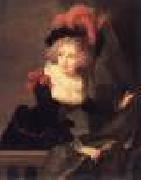 |
VIGEE-LEBRUN, Elisabeth
|
|
French painter (full name: Marie-Louise-Élisabeth Vigee-Lebrun). Vigee LeBrun's most famous client was Marie Antoinette, France's much maligned queen. When the two met in 1778, Vigee LeBrun's art-dealer husband had gambled away his wife's earnings. Still, she was dauntless and set out to establish her own salon where she would court royal clients. In a November 1982 article for Art in America, Brooks Adams noted that in her memoirs, Vigee LeBrun said that her much sought-after salon was, "a place where art and society mixed, where noblemen and ministers were content to sit on the floor, to avoid the stiff, formal court entertainments at Versailles." In time, her portraits and memoirs alike painted a portrait of Vigee LeBrun as a woman born to contend with anyone. Unfortunate Circumstances Marie Louise Elisabeth Vigee LeBrun was born in 1755 in Paris. Her father was Louis Vigee, a little-known portrait artist who worked in pastels. From the time she was small, he taught his daughter the skills of the trade. She proved to be somewhat of a prodigy. Her parents placed Vigee LeBrun in the convent of La Trinite, directly behind the Bastille. Her earliest memories were of drawing so frantically on the walls of her dormitory that the sisters regularly punished her. When her father died, Vigee LeBrun was only 12. He had been her biggest supporter. For an article in Antiques, magazine in November 1967, Ilse Bischoff quoted Vigee LeBrun's father after he saw a drawing she had done as a small child. It was the head of a bearded man with the light of a lamp falling on his face. She took care to observe light and shade, and showed skill beyond her years. Her father had exclaimed, "You will be a painter if I ever saw one." By the time she was 15, Vigee LeBrun had established a business as a painter that provided major financial support for her family. Her mother was a hairdresser from Luxembourg, who remarried not long after her first husband's death. Her stepfather soon began to squander her earnings. When she was only 21, she married an art dealer named Pierre LeBrun. It was clearly a marriage more of convenience, than of love. They had one daughter, Julie, born in 1780. Vigee LeBrun's marriage helped her gain access to a world normally restricted to men. Although she was denied access to a male apprentice system, and was unable to participate in classes at the major art academies around the city, she gained admission to the lesser salon of the Academie de Saint Luc. However, the Academie Royale was closed to her without proper connections. In those days, being shown in lesser salons kept a painter away from the financial benefits to be gained from wealthier clients who frequented the prestigious Academie Royale. When Vigee LeBrun was finally admitted to the Royale in 1783, her critics were not kind. She was accused of using her husband and the palace, most particularly her friendship with Queen Marie Antoinette. Another unfortunate rumor was that she had a long-standing sexual affair with the finance minister, Calonne. Her accusers contended that he aided her in squandering much of the Royal Treasury. That was never proven. Still, it was clear that she capitalized on her associations with the queen and the rest of the royal family. The aristocracy longed to be seen as simple, especially as unrest grew among the people outside of the palace confines. One portrait of Marie Antoinette was considered so scandalously informal, that it was withdrawn from the salon in the midst of her debut at the Academie Royale. Vigee LeBrun's arch-rival was a woman painter named Madame Labille Guiard. They were admitted to the Academie Royale on the same day. For the rest of the decade, before the French Revolution erupted in 1789, the two women maintained their rivalry. At the time of the academy's biennial exhibitions, the bitterness they felt toward each other had reached the height of its intensity. Vigee LeBrun painted one of her most acclaimed works in 1784. It was the portrait of Marie-Gabrielle de Gramont, Duchess of Caderousse. That was the same year she suffered a miscarriage, and painted only five portraits. Her usual output far exceeded that. The portrait was shown at the Salon of 1785 to much acclaim and became one of the artist's most celebrated works. In her memoirs, written fifty years later, Vigee LeBrun recalled the painting. "As I detested the female style of dress then in fashion, I bent all my efforts upon rendering it a little more picturesque, and was delighted when, after getting the confidence of my models, I was able to drape them according to my fancy. Shawls were not yet worn, but I made an arrangement with broad scarfs lightly intertwined around the body and on the arms, which was an attempt to imitate the beautiful drapings of Raphael and Domenichino I could not endure powder persuaded the Duchess to put none on for her sittings." Thrived in Exile Vigee LeBrun was not immune to the anxious rumbling that became the French Revolution. What had begun on that fateful night of July 14, 1789, erupted further when mobs stormed the palace at Versailles on the following October 6. Vigee LeBrun had been in disfavor for her association with Marie Antoinette for some time and was considered to be a royal sympathizer. |
|
|
|
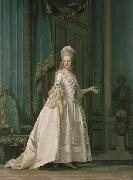 |
Vigilius Eriksen
|
|
(b Copenhagen, 2 Sept 1722; d Copenhagen, 23 or 24 May 1783). Danish painter, active also in Russia. He was apprenticed to the portrait painter Johann Salomon Wahl in Copenhagen. In 1755 he competed unsuccessfully for the gold medal at the Royal Academy of Art in Copenhagen with a historical painting, Lot and his Wife (untraced). In a letter he complained that the rules did not allow him to enter a portrait, a genre more suited to his talents. Presumably in 1756 he completed the portraits of the registrar of the royal art collections, Lorenz Spengler and his Wife (Copenhagen, Stat. Mus. Kst). |
|
|
|
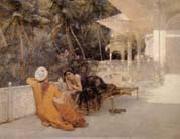 |
Weeks Lord-Edwin
|
|
189-1903
American artist, was born at Boston, Massachusetts, in 1849. He was a pupil of Leon Bonnat and of Jean-Leon Gerome, at Paris. He made many voyages to the East, and was distinguished as a painter of oriental scenes. In 1895 he wrote and illustrated a book of travels, From the Black Sea through Persia and India, and two years later he published Episodes of Mountaineering. He died in November 1903. He was a member of the Legion d'honneur, France, an officer of the Order of St. Michael, Germany, and a member of the Secession, Munich. |
|
|
|
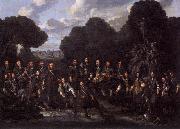 |
Willem Eversdijck
|
|
the son of Cornelis Eversdijck, flourished at Goes about the year 1660. He was a portrait painter, and several of his portraits were engraved by Houbraken. A picture of Officers and Members of the Company of Archers, called " Edele Voetboog," at Goes, by him, is in the Rotterdam Museum.
Cornelis Willemsz Eversdijck, his father, was also a portrait painter of Goes, who died there in 1649. In the Rotterdam Museum are three pictures by him, representing Officers and Members of the Company of Archers, called "Edele Voetboog," at Goes; two of which are dated 1616 and 1624.
|
|
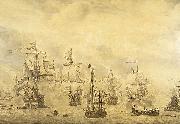 |
Willem van de Velde the Elder
|
|
(c. 1611 - 13 December 1693) was a Dutch Golden Age seascape painter.
Willem van de Velde, known as the Elder, a marine draughtsman and painter, was born in Leiden, the son of a Flemish skipper, Willem Willemsz. van de Velde, and is commonly said to have been bred to the sea. In 1706 Bainbrigg Buckeridge noted that he eunderstood navigation very welle. He married Judith Adriaensdochter van Leeuwen in Leiden, the Netherlands, in 1631.
His three known legitimate children were named Magdalena, born 1632; Willem, known as the Younger, also a marine painter, born 1633; and Adriaen, a landscape painter, born 1636.
His marriage was stormy, at least in its later years. David Cordingly relates that Willem the Elder fathered two children out of wedlock in 1653, one eby his maidservant, and the other by her friend. Nine years later the Elder and his wife went through a legal separation, eon account of legal disputes and the most violent quarrelse. The immediate cause of the dispute was his affair with a married woman.e Michael S. Robinson noted that eon 17/27 July 1662, he and his wife agreed to part. A condition of the separation was that the Elder could recover from his son Adriaen etwo royal giftse, presumably gifts from Charles II for work done in England.e Cordinglyes account further relates that the dispute was still continuing after another ten years, since ein the autumn of 1672 Judith complained to the womanes husband.e Robinson adds that by 1674 the couple emust have been reconcilede, for at a chance meeting with Pieter Blaeu in Amsterdam in July the Elder explained that he was only visiting for a few days ein order to fetch his wifee. His son, Adriaen, had died in Amsterdam in 1672, and Willem the Elder was also fetching his grandson, similarly named Adriaen, who was then aged two.
After his move to England, the exact date of which is uncertain, but reportedly at the end of 1672 or beginning of 1673, he is said to have lived with his family in East Lane, Greenwich, and to have used the Queenes House, now part of the National Maritime Museum in Greenwich, as a studio. Following the accession of William and Mary as King and Queen of England, it appears that this facility was no longer provided, and by 1691 he was living in Sackville Street, now close to Piccadilly Circus. He died in London, and was buried in St Jameses Church, at the south end of the street.
|
|
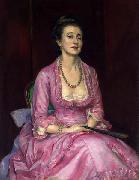 |
William Bruce Ellis Ranken
|
|
United Kingdom (1881- 1941 ) - Watercolours
painted Souvenir of the seventies. Signed with monogram and dated 1923 |
|
|
|
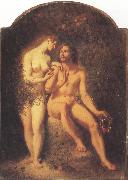 |
William Edward frost R.A.
|
|
1810-1877
was an English painter of the Victorian era. Virtually alone among English artists in the middle Victorian period, he devoted his practice to the portrayal of the female nude. Frost was educated in the schools of the Royal Academy, beginning in 1829; he established a reputation as a portrait painter before branching into historical and mythological subjects, including the sub-genre of fairy painting that was characteristic of Victorian art. In 1839 he won the Royal Academy's gold medal for his "Prometheus Bound," and in 1843 he won a prize in the Westminster Hall competition for his "Una Alarmed by Fauns" (a subject from Spenser's The Faerie Queen). He was elected an associate member of the Royal Academy in 1846, and a full member in 1870. Frost is widely recognized as a follower of William Etty, who preceded him as the primary British painter of nudes in the second quarter of the nineteenth century. |
|
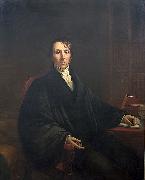 |
William Ellery Channing
|
|
(April 7, 1780 - October 2, 1842) was the foremost Unitarian preacher in the United States in the early nineteenth century and, along with Andrews Norton, one of Unitarianism's leading theologians. He was known for his articulate and impassioned sermons and public speeches, and as a prominent thinker in the liberal theology of the day. |
|
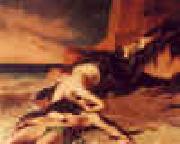 |
William Etty
|
|
1787-1849
English
William Etty Location
English painter. Born into a Methodist family, he was the seventh child of a miller and baker in Feasegate, York, and in 1798 he was apprenticed as a printer to Robert Peck, publisher of the Hull Packet. Financial support from his uncle, a banker, allowed him to go to London in 1805, where he entered the Royal Academy Schools in 1806. For a year, in 1807-8, he was a pupil of Thomas Lawrence, who greatly influenced him. Following the death of his uncle in 1809 he became financially secure. From 1811 he exhibited regularly at the Royal Academy and the British Institution and in 1816 worked in the studio of Jean-Baptiste Regnault in Paris. |
|
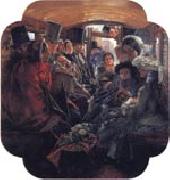 |
William Maw Egley
|
|
English painter , (1826-1916)
was a British artist of the Victorian era. The son of the miniaturist William Egley, he studied under his father. His early works were illustrations of literary subjects typical of the period, such as Prospero and Miranda from The Tempest. These were similar to the work of The Clique. William Powell Frith, one of The Clique, hired Egley to add backgrounds to his own work. Egley soon developed a style influenced by Frith, including domestic and childhood subjects. Most of his paintings were humorous or "feelgood" genre scenes of urban and rural life, depicting such subjects as harvest festivals and contemporary fashions. His best known painting, Omnibus Life in London (Tate Gallery) is a comic scene of people squashed together in the busy, cramped public transport of the era. Egley always showed great interest in specifics of costume, to which he paid detailed attention, but his paintings were often criticised for their hard, clumsy style. In the 1860s Egley adopted the fashion for romanticised 18th century subjects. |
|
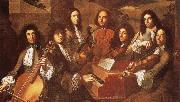 |
william wordsworth
|
|
Born: 7 April 1770
Birthplace: Cockermouth, England
Died: 23 April 1850
Best Known As: The author of the poem "Tintern Abbey"
|
|
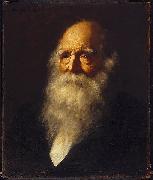 |
Wyatt Eaton
|
|
(May 6, 1849 - June 7, 1896) was an Canadian/American portrait and figure painter, remembered as one of the founders of the Society of American Artists.
Born in Philipsburg, Quebec, Lower Canada, Eaton was a student of the National Academy of Design, New York. In 1872, he moved to Paris and studied at the École des Beaux-Arts under Jean-Leon Gerôme. During this time, he made the acquaintance of Jean-François Millet at Barbizon, and was also influenced by his friend Jules Bastien-Lepage.
After his return to the United States in 1877, he became a teacher in the Cooper Institute, and opened a studio in New York City. He became one of the founders of the Society of American Artists, in which he was the first secretary. Eaton died from tuberculosis at Newport, Rhode Island on June 7, 1896.
|
|
|

